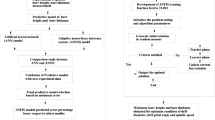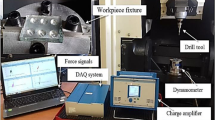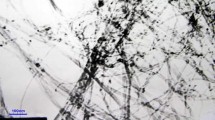Abstract
In this study, the effect of drilling 6061-T651 aluminum alloy with different lengths of indexable insert drills, called U drills, on thrust force, torque, and surface roughness was investigated. As input parameters, length-to-diameter ratio, feed rate, and cutting speed were chosen for experimental works. The optimum values of the test parameters were determined by the ratio of signal to noise. In addition, output responses were modeled and compared with Taguchi, artificial neural networks (ANN), and the adaptive neuro-fuzzy inference system (ANFIS) methods. Both the experimental results and the signal-to-noise ratios derived from the experimental results were employed in the modeling process. The models with the highest accuracy were created using ANN when the predicted results from the models were compared to the experimental findings. The MAPE values of the ANN model created with the SN ratio were obtained as 0.18% for thrust force, 0.17% for torque, and 1.79% for surface roughness. Converting the output responses to SN ratios and using them in the models enabled the estimation of thrust, torque, and surface roughness with less error and satisfactory reliability. With the method proposed in this study, output responses according to input variables can be predicted with higher precision, resulting in the efficiency and reliability required by the industry.















Similar content being viewed by others
References
Lee W S and Tang Z C 2014 Relationship between mechanical properties and microstructural response of 6061–T6 aluminum alloy impacted at elevated temperatures. Mater. Des. 58: 116–124
Dhakal B and Swaroop S 2020 Effect of laser shock peening on mechanical and microstructural aspects of 6061–T6 aluminum alloy. J. Mater. Process.Technol. 282: 116–640
Rahmati B, Sarhan A A and Sayuti M 2014 Morphology of surface generated by end milling AL 6061–T6 using molybdenum disulfide (MoS2) nanolubrication in end milling machining. J. Clean. Prod. 66: 685–691
Rodriguez R I, Jordon J B, Allison P G, Rushing T and Garcia L 2015 Microstructure and mechanical properties of dissimilar friction stir welding of 6061-to-7050 aluminum alloys. Mater. Des. 83: 60–65
Astakhov V P 2014 Drills: science and technology of advanced operations. CRC Press, Boca Raton
Haitao L, Jia F, Tingke W, Ning C and Huadong L 2021 Numerical simulation and experimental study on the drilling process of 7075–t6 aerospace aluminum alloy. Materials 14(3): 553
Chu N H, Nguyen V D and Do T V 2018 Ultrasonic-assisted cutting: A beneficial application for temperature, torque reduction, and cutting ability improvement in deep drilling of Al-6061. Appl. Sci. 8(10): 1708
Mohammad U, Animesh B, Alokesh P, Sunpreet S, Grzegorz M K and Chander P 2018 Evaluating hole quality in drilling of Al 6061 alloys. Materials 11(12): 2443
Lee B, Liu H and Tarng Y 1998 Modeling and optimization of drilling process. J. Mater. Process. Technol. 74(1–3): 149–157
Parsian A 2018 Regenerative Chatter Vibration in Indexable Drills: Modeling and Simulation. PhD Thesis, University West, USA
Heisel U and Schaal M 2009 Burr formation in short hole drilling with minimum quantity lubrication. Prod. Eng. 3(2): 57–163
Biermann D and Hartmann H 2012 Reduction of burr formation in drilling using cryogenic process cooling. Procedia CIRP 3: 85–90
Kaymakci M, Kilic Z and Altintas Y 2012 Unified cutting force model for turning, boring, drilling and milling operations. Int. J. Mach. Tools Manuf. 54: 34–45
Kilic Z and Altintas Y 2016 Generalized mechanics and dynamics of metal cutting operations for unified simulations. Int. J. Mach. Tools Manuf. 104: 1–13
Rajyalakshmi M and Rao M V 2022 Application of artificial neural networks and genetic algorithm for optimizing process parameters in pocket milling of AA7075. J. Sci. Ind. Res. 81: 911–921
Yalcin U, Karaoglan A D and Korkut I 2013 Optimization of cutting parameters in face milling with neural networks and Taguchi based on cutting force, surface roughness and temperatures. Int. J. Prod Res. 51(11): 3404–3414
Tanikić D 2020 Computationally intelligent optimization of metal cutting regimes. Measurement 152: 107358
Dedeakayoğulları H, Kaçal A and Keser K 2022 Modeling and prediction of surface roughness at the drilling of SLM-Ti6Al4V parts manufactured with pre-hole with optimized ANN and ANFIS. Measurement 203: 112029
Chern G L and Lee H J 2006 Using workpiece vibration cutting for micro-drilling. Int. J. Adv. Manuf. Technol. 27(7): 688–692
Chang S S and Bone G M 2010 Burr height model for vibration assisted drilling of aluminum 6061–T6. Precis. Eng. 34(3): 369–375
Ravisubramanian S and Shunmugam M 2015 On reliable measurement of micro drilling forces and identification of different phases. Measurement 73: 335–340
Moghaddas M, Yi A and Graff K 2019 Temperature measurement in the ultrasonic-assisted drilling process. Int. J. Adv. Manuf. Technol. 103(1): 187–199
Seif C Y, Hage I S and Hamade R F 2019 Utilizing the drill cutting lip to extract Johnson Cook flow stress parameters for Al6061-T6. CIRP J. Manuf. Sci. Technol. 26: 26–40
Bain G and Raj D S 2022 Effect of EDMed rake face grooves on the chip breaking capability of twist drills during deep hole drilling of Al 6061 aluminum alloy. Mater. Manuf. Process. 37(9): 1052–1072
Dhawan V, Debnath K, Singh I and Singh S 2016 A novel intelligent software-based approach to predict forces and delamination during drilling of fiber-reinforced plastics. Proc. Inst. Mech. Eng. Part L J. Mater. Des. Appl. 230(2): 603–614
Aguiar P R, Da Silva R B, Gerônimo T M, Franchin M N and Bianchi E C 2017 Estimating high precision hole diameters of aerospace alloys using artificial intelligence systems: a comparative analysis of different techniques. J. Brazil. Soc. Mech. Sci. Eng. 39(1): 127–153
Meral G, Sarıkaya M, Mia M, Dilipak H, Şeker U and Gupta M K 2019 Multi-objective optimization of surface roughness, thrust force, and torque produced by novel drill geometries using Taguchi-based GRA. Int. J. Adv. Manuf. Technol. 101(5): 1595–1610
Mondal N, Mandal S and Mandal M C 2020 FPA based optimization of drilling burr using regression analysis and ANN model. Measurement 152: 107327
Valarmathi T N, Palanikumar K, Sekar S and Latha B 2020 Investigation of the effect of process parameters on surface roughness in drilling of particleboard composite panels using adaptive neuro fuzzy inference system. Mater. Manuf. Process. 35(4): 469–477
Kumar R and Hynes N R J 2020 Prediction and optimization of surface roughness in thermal drilling using integrated ANFIS and GA approach. Eng. Sci. Technol. Int. J. 23(1): 30–41
Seçgin Ö and Sogut M Z 2021 Surface roughness optimization in milling operation for aluminum alloy (Al 6061–T6) in aviation manufacturing elements. Aircraft Eng. Aerosp. Technol. 93(8): 1367–1374
Manoharan M, Kulandaivel A, Arunagiri A, Refaai R M A, Yishak S and Buddharsamy G 2021 Statistical modelling to study the implications of coated tools for machining AA 2014 using grey taguchi-based response surface methodology. Adv. Mater. Sci. Eng. 2021: 1–20
Lin Z and Yang C 2010 Combining the Taguchi method with an artificial neural network to construct a prediction model for near-field photolithography experiments. Proc. Inst. Mech. Eng. Part C J. Mech. Eng. Sci. 224(10): 2223–2233
Khorasani A M, Gibson I, Goldberg M and Littlefair G 2018 A comprehensive study on surface quality in 5-axis milling of SLM Ti-6Al-4V spherical components. Int. J. Adv. Manuf. Technol. 94(9): 3765–3784
Tamiloli N, Venkatesan J and SampathKumar T 2022 ANFIS based forecast and parametric investigation during processing activity of AA6082T6. Mater. Manuf. Process. 37(1): 99–112
Pontes F J, Ferreira J R, Silva M B, Paiva A P and Balestrassi P P 2010 Artificial neural networks for machining processes surface roughness modeling. Int. J. Adv. Manuf. Technol. 49(9): 879–902
Jang J S 1993 ANFIS: adaptive-network-based fuzzy inference system. IEEE Trans. Syst. Man Cybernet. 23(3): 665–685
Sharma D, Bhowmick A and Goyal A 2022 Enhancing EDM performance characteristics of Inconel 625 superalloy using response surface methodology and ANFIS integrated approach. CIRP J. Manuf. Sci. Technol. 37: 155–173
Acknowledgement
This work was supported by the Gazi University Scientific Research Projects Unit with the code 07/2019-08. Authors thank the Gazi University BAP unit for their support.
Author information
Authors and Affiliations
Corresponding author
Ethics declarations
Competing interest
The authors declare that they have no known competing financial interests or personal relationships that could have appeared to influence the work reported in this paper.
Rights and permissions
About this article
Cite this article
Akdulum, A., Kayir, Y. Modeling and estimation of thrust force, torque, and surface roughness in indexable drilling of AA6061-T651 with Taguchi, ANN, and ANFIS. Sādhanā 48, 143 (2023). https://doi.org/10.1007/s12046-023-02209-w
Received:
Revised:
Accepted:
Published:
DOI: https://doi.org/10.1007/s12046-023-02209-w




